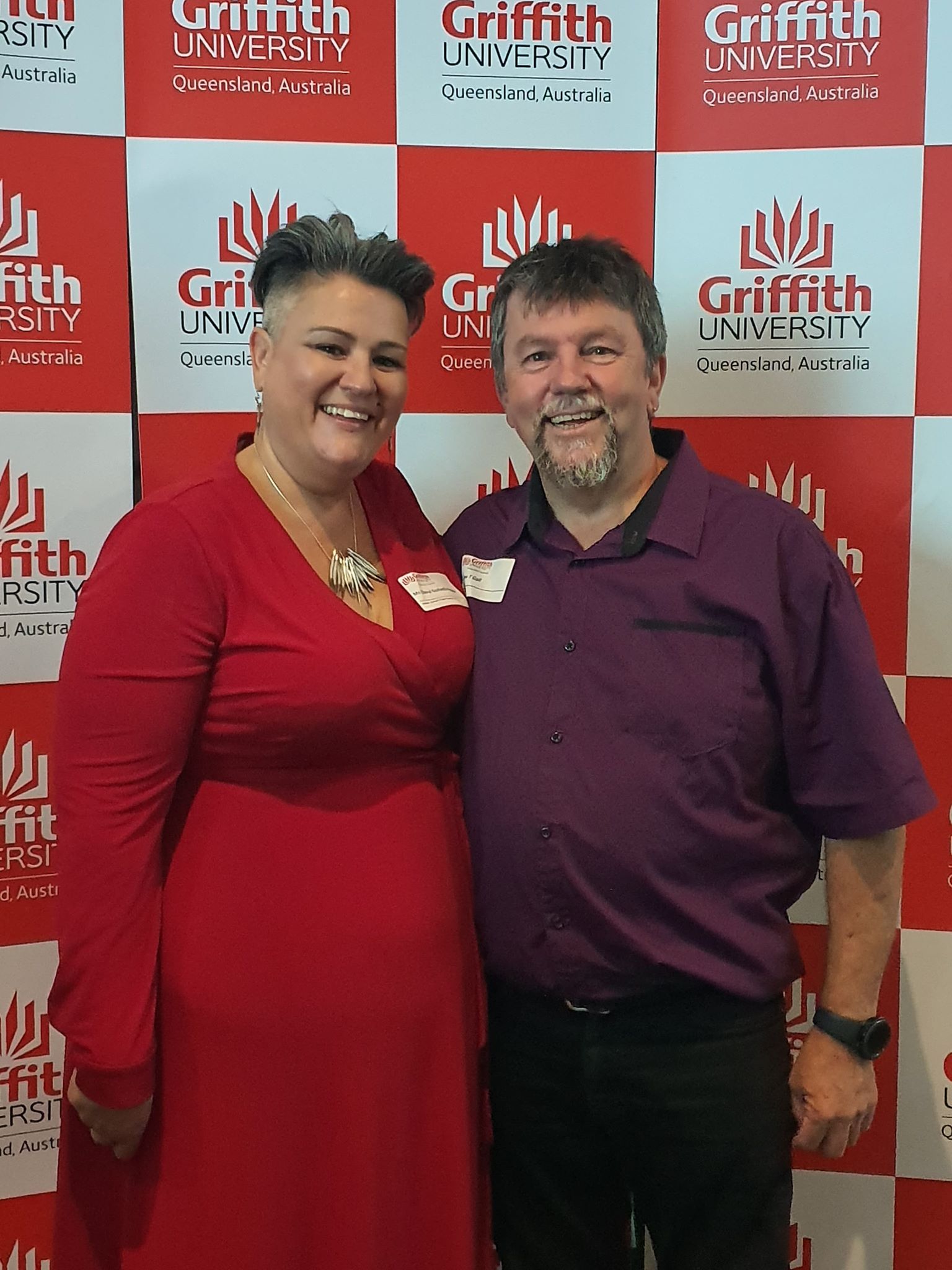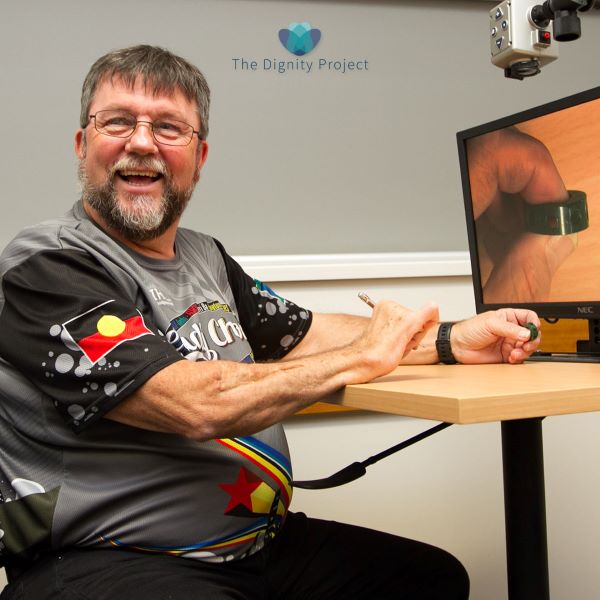Andrew Gall: ‘Try a little kindness’
Andrew Gall, whose spiritual name is kurina – is a pakana (Aboriginal man) from Iutruwita (Tasmania) who is currently completing his Doctorate in Visual Arts (PhD) with Queensland College of Art, Griffith University.
Andrew, as a First Australian, has strong ties to his culture, practicing traditional ways of being, including hunting for food and natural medicine. His art practice, which includes traditional painting, digital printmaking and jewellery manufacture, stems from stories about his people’s traditional lands and heritage, as well as his personal and spiritual past.
Andrew’s life journey was changed forever – when, as a teen, he was shot in the right forearm with a 12-gauge shotgun. Andrew recalls that ‘this should have a) killed me or b) left me without a right arm. But neither happened, due to the foresight of a surgeon who had just learnt of a new technique that might save my arm. I was told by the surgical nurses that Dr Morgan made a call and said to everyone, "we are going to try this new technique, if we try and it fails, at least we tried".’ The surgery was a success, and whilst Andrew has limitations with the use of his right arm, his resolve to keep moving forward with his dreams and goals through continued education and positive determination has been life changing.
As a young school student, one of Andrew’s first experiences that shaped the path he would soon follow, was having a teacher who suggested he could not become an artist, due to his disability. Undeterred, after graduating from secondary school, Andrew started a journey down the road called the Bachelor of Contemporary Australian Indigenous Art, and it was at this time ‘the words of this teacher came back to me, especially at times of critique or examinations.’
‘It was not until three quarters of the way through my honours year, when I stood up to present a small story of my art, when towards the end of the presentation, my lecturer Dr Laini Burton said “Andrew, it would appear that you do not consider yourself an artist, is this so?” I paused for a couple of seconds before I answered… “Laini, yes I have not been considering myself as an artist, however, I believe I am”, I then went on to tell the story about the teacher from my past, her words and how they affected me.’
Andrew has had many more lived experiences and realisations about his potential to become a successful Aboriginal Artist and jeweller, which have shaped the man he has become today. As an artist, academic, researcher and powerful advocate for disability inclusion and diversity, he is passionate about the benefits of continued education, particularly for First Nations Peoples and those with disabilities.
Andrew’s journey is now dedicated towards challenging society’s perception of what people living with disability can achieve and contribute, in addition to using his personal experience of managing systems to help others. ‘To achieve your potential, whether you have a disability or come from a strong cultural background, or perhaps you are both, [focus on] what is in your heart and start down the path to achieve it. This pathway can be riddled with ruts of doubt and stones of negativity, but it also has gateways to success, and it is these gateways you need to focus on – because that is where your potential is’ asserts Andrew. ‘Everything I have done, I have done off my own bat, by following a journey which has had multiple forks containing even more journeys, which ultimately make up the journey of life.’
The journey of life, as a First Australian, is an important part of Andrew’s art practise. ‘Storytelling in my culture, is the way in which kani ngini (old speak) and lore is shared and handed down. All my artworks and jewellery designs have a cultural name and story behind it. With my jewellery, I am utilising palawa Kani (my language) in the naming process, and by doing this, I am able to share my culture with the greater population. The name of my art provokes conversation… conversations are a key to knowledge and understanding – particularly in my own culture. Thus, I’m hoping by sharing my journey, it may open doors for other people, who may have a disability and would like to travel down the road of becoming an artist – and all of its varieties from painting and sculpture to jewellery, and not be hindered by words spoken in the past… because you can do it!’
Technology and its evolution is something that has had huge implications in the success and enjoyment of Andrew’s studies and art practise. Andrew uses a voice recognition software program called ‘Dragon’ that helps him word process assignments and anything else that needs to be presented as digital content. ‘It is great, as the disability in my right hand hinders me from doing much typing at all’ said Andrew. Andrew also has ‘Sonocent’ dictation software installed on his phone and PC which helps to take notes, by recording the lecturer, tutor or mentor, so that it can be transcribed later. ‘Both programs work hand in glove… also, there is another piece of technology that I would like – and that is a bionic forearm.’
As an advocate and academic, who works in the disability sphere, Andrew has strong feelings about what dignity means to him. ‘To me, dignity is my right to be valued and respected as a person, regardless of how I look, how I talk, how I walk, or how I write… that’s what dignity means to me. There is an incident that will be with me for the rest of my life… one that was a game changer in the way in which I viewed disability. This incident occurred way back in 1975 by myself and my peers, as we were about to graduate high school, and we had to inform the school’s Careers Guidance Officer what we wanted to do career-wise, after leaving school. Not long after this, we had a visit from the Commonwealth Employment Services (CES) Vocational Officer, whose role it was to inform and provide us with relevant information and contacts regarding our chosen path. After this officer had spoken with all my peers, it appeared that I would be last, however the Vocational Officer started packing away his information. I put my hand up to get his attention, and when I did, I asked, “what about me?” He looked up and he said, “you’re Andrew… your disabled, you will not need to work”, my response was not good at all. I had never considered myself disabled, in any way, shape or form – and from that day, I made sure that I chose some of the hardest and physically demanding jobs that I could take, and the rest is history. No one should be judged by the way they look, by the way they talk, or the way they walk, by the clothes they wear, or by the colour of their skin – after all, we are all humans’.
Of what he believes needs to be done to ensure everybody is treated equally and equitably in all aspects of life, Andrew stops to ponder… ‘Here is a question which is so huge! So much has been achieved already, but it is like trying to melt an iceberg with a candle – it can be done, but it will take a huge candle and a lot of time. Education and communication are the most prominent tools at our disposal, and one that always should work hand in hand. Shining a light on the success stories, highlighting the inequality that exists, and providing solutions to these problems are vital in moving forward’.
Andrew’s advice for Dignity Community Hub Members who are looking to achieve long held dreams and goals, is that ‘it does not matter how far along in your journey you are; you can still learn new things, you do not have to stay on one path, there is so much more out there for us all. Above all you do, be true to yourself, treat yourself the way you would like to be treated, and even if you don’t feel like it, try a little kindness.’
All the best on your journeys!
kurina


Images left to right: Andrew and Cheryl Cheryl Goodwell-Pepper Director of Gumurri at Griffith University; Andrew Gall.
Tags: Andrew Gall, Aboriginal, Artist, Dignity Project, National Close The Gap Day
Related Articles
- THC Researcher awarded GU New Researcher Grant for study in social and emotional wellbeing
- The Importance of Dignity and The Dignity Project
- Media Release - Launch of The Dignity Project Citizen Science Initiative
- Share your stories and be part of meaningful change!
- Welcome to the Community Hub

